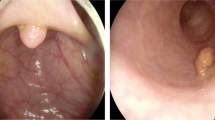Abstract
Purpose
The size information of detected polyps is an essential factor for diagnosis in colon cancer screening. For example, adenomas and sessile serrated polyps that are \(\ge 10\) mm are considered advanced, and shorter surveillance intervals are recommended for smaller polyps. However, sometimes the subjective estimations of endoscopists are incorrect and overestimate the sizes. To circumvent these difficulties, we developed a method for automatic binary polyp-size classification between two polyp sizes: from 1 to 9 mm and \(\ge 10\) mm.
Method
We introduce a binary polyp-size classification method that estimates a polyp’s three-dimensional spatial information. This estimation is comprised of polyp localisation and depth estimation. The combination of location and depth information expresses a polyp’s three-dimensional shape. In experiments, we quantitatively and qualitatively evaluate the proposed method using 787 polyps of both protruded and flat types.
Results
The proposed method’s best classification accuracy outperformed the fine-tuned state-of-the-art image classification methods. Post-processing of sequential voting increased the classification accuracy and achieved classification accuracy of 0.81 and 0.88 for polyps ranging from 1 to 9 mm and others that are \(\ge 10\) mm. Qualitative analysis revealed the importance of polyp localisation even in polyp-size classification.
Conclusions
We developed a binary polyp-size classification method by utilising the estimated three-dimensional shape of a polyp. Experiments demonstrated accurate classification for both protruded- and flat-type polyps, even though the flat type have ambiguous boundary between a polyp and colon wall.











Similar content being viewed by others
References
Hassan C, Repici A, Rex D (2016) Addressing bias in polyp size measurement. Endoscopy 48(10):881–883
Lieberman DA, Rex DK, Winawer SJ, Giardiello FM, Johnson DA, Levin TR (2012) Guidelines for colonoscopy surveillance after screening and polypectomy: a consensus update by the US Multi-Society Task Force on Colorectal Cancer. Gastroenterology 143(3):844–857
Hassan C, Quintero E, Dumonceau J-M, Regula J, Brandão C, Chaussade S, Dekker E, Dinis-Ribeiro M, Ferlitsch M, Gimeno-García A, Hazewinkel Y, Jover R, Kalager M, Loberg L, Pox C, Rembacken B, Lieberman D (2013) Post-polypectomy colonoscopy surveillance: European Society of Gastrointestinal Endoscopy (ESGE) Guideline. Endoscopy 45(10):842–864
Anderson B, Smyrk T, Anderson K, Mahoney D, Dovens M, Sweetser S, Kisiel J, Ahlquist D (2015) Endoscopic overestimation of colorectal polyp size. Gastrointestinal Endoscopy 83(1):201–208
Rex DK, Rabinovitz R (2014) Variable interpretation of polyp size by using open forceps by experienced colonoscopists. Gastrointestinal Endoscopy 79(3):402–407
Hyun YS, Han DS, Bae JH, Park HS, Eun CS (2011) Graduated injection needles and snares for polypectomy are useful for measuring colorectal polyp size. Digestive and Liver Disease 43(5):391–394
Kaz AM, Anwar A, O’Neill DR, Dominitz JA (2016) Use of a novel polyp “ruler snare’’ improves estimation of colon polyp size. Gastrointest Endoscopy 83(4):812–816
Plumb A, Nickerson C, Wooldrage K, Bassett P, Taylor S, Altman D, Atkin W, Halligan S (2016) Terminal digit preference biases polyp size measurements at endoscopy, computed tomographic colonography, and histopathology. Endoscopy 48:899–908
Itoh H, Roth HR, Lu L, Oda M, Misawa M, Mori Y, Kudo S-E, Mori K (2018) Towards Automated Colonoscopy Diagnosis: Binary Polyp Size Estimation via Unsupervised Depth Learning. Proc. Medical Image Computing and Computer Assisted Intervention LNCS 11071:611–619
Itoh Oda M, Mori Y, Misawa M, Kudo S-E, Imai K, Ito S, Hotta K, Takabatake H, Mori M, Natori H, Mori K (2021) Unsupervised Colonoscopic Depth Estimation with a Lambertian-Reflection Keeping Auxiliary Task. International Journal of Computer Assisted Radiology and Surgery 16:989–1001
Redmon J, Farhadi A (2018) YOLOv3: an incremental improvement. CoRR arXiv:1804.02767https://pjreddie.com/darknet/yolo/
Mori K, Suenaga Y, Toriwaki J (2003) Fast Software-based Volume Rendering Using Multimedia Instructions on PC Platforms and Its Application to Virtual Endoscopy. Proc SPIE Medical Imaging 5031:111–122
Misawa M, Kudo S-E, Mori Y, Hotta K, Ohtsuka K, Matsuda T, Saito S, Kudo T, BaBa T, Ishida F, Itoh H, Oda M, Mori K (2021) Development of a computer-aided detection system for colonoscopy and a publicly accessible large colonoscopy video database (with video). Gastrointestinal Endoscopy 93(4):960–967
Itoh H, Misawa M, Mori Y, Oda M, Shin-Ei Kudo, Mori K (2020) SUN Colonoscopy Video Database. http://amed8k.sundatabase.org/
Lausberg H, Sloetjes H (2009) Coding gestural behavior with the NEUROGES-ELAN system. Behav Res Methods 41:841–849, https://tla.mpi.nl/tools/tla-tools/elan/
Zoph B, Vasudevan V, Shlens J, Le QV (2018) Learning transferable architectures for scalable image recognition. In: Proceedings of IEEE international conference on computer vision, pp 8697–8710
Szegedy C, Ioffe S, Vanhoucke V, Alemi A (2017) Inception-v4, Inception-ResNet and the impact of residual connections on learning. In: Proceedings of thirty-first AAAI conference on artificial intelligence, pp 4278–4284
Chollet F (2017) Xception: deep learning with depthwise separable convolutions. In: Proceedings of IEEE international conference on computer vision, pp 1800–1807
Acknowledgements
This study was funded by Grants from AMED 445 (19hs0110006h0003), JSPS MEXT KAKENHI (26108006, 17H00867, 446 17K20099), JST CREST (JPMJCR20D5), and the JSPS Bilateral Joint Research Project. 447.
Author information
Authors and Affiliations
Corresponding author
Ethics declarations
Conflict of interest
Kudo SE, Misawa M, and Imai K received lecture fees from Olympus. Mori Y and Hotta K received consultant and lecture fees from Olympus. Mori K is supported by Cybernet Systems and Olympus (research grant) in this work and by NTT outside of the submitted work. The other authors have no conflicts of interest.
Ethical approval
All the procedures performed in studies involving human participants were in accordance with the ethical committee of Nagoya University (No. 357), the Shizuoka Cancer Center (No. T30-45-30-1-5), and the 1964 Helsinki declaration and subsequent amendments or comparable ethical standards. Informed consent was obtained by an opt-out procedure from all individual participants in this study.
Additional information
Publisher's Note
Springer Nature remains neutral with regard to jurisdictional claims in published maps and institutional affiliations.
Rights and permissions
About this article
Cite this article
Itoh, H., Oda, M., Jiang, K. et al. Binary polyp-size classification based on deep-learned spatial information. Int J CARS 16, 1817–1828 (2021). https://doi.org/10.1007/s11548-021-02477-z
Received:
Accepted:
Published:
Issue Date:
DOI: https://doi.org/10.1007/s11548-021-02477-z




